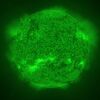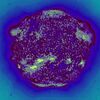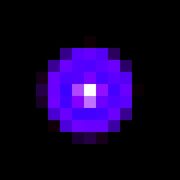A "star" is large celestial body that is spherical (except in universes with different laws of physics and higher dimensions) under its own gravity (i.e., in hydrostatic equilibrium) and releases large amounts of heat and light energy through nuclear fusion. They are composed mainly of hydrogen and helium. They are found in the centres of solar systems, and can be orbited by several planets and occasionally smaller stars.
Classes[]
There are a variety of different stellar classes, each of which with their own unique properties. There are a lot of star classes that exist in our universe; here is a list.
Class O stars[]
A Class O star is the brightest and hottest type of star, sitting on the line between main sequence and giant. Traditionally, they are coloured blue. They are also the rarest type of main-sequence star, making up only 0.00001% of luminous stars. A typical class O star has a mass of 50 solar masses, a radius of 10 solar radii, a luminosity of 100,000 solar luminosities, a surface temperature of 40000 K and a lifespan of 10 million years.
The habitable zone of a typical O-Class star is on the order of 500 AU. This, coupled with their short lifespans, makes them poor candidates for having solar systems, especially those that support life.
Class B stars[]
A "Class B star" is the second-brightest type of main sequence star. They are typically colored blue-white, slightly less blue than O-type stars. They are fairly rare, making up only 0.13% of main-sequence stars. A typical Class B star has a mass of 9 (2 to 16) solar masses, a radius of 4 (2 to 7) solar radii, a luminosity of 1,000 (25 to 30,000) solar luminosities, a surface temperature of 20,000 K (10,000 K to 30,000 K), and a lifespan of 40 million years.
The habitable zone of a typical Class B star is on the order of 50 AU. While they also possess short lifespans, making planets and life rare, there are a few examples of B-type star systems, including HIP 78530.
Class A stars[]
"Class A stars" are bright White-Blue main sequence stars that tend to have a short lifespan, and are the third warmest type of star. they have extremely high temperatures far greater than out sun, the reason for this is because of its massive hydrogen consumption. These stars usually have twice the mass and size of our sun examples are Sirius, Vega, Altair. It is rare for this stars to have rocky planets since these stars are really hot and rocky planets might be instantly molten or turned into gas or plasma.
Class F stars[]
A "Class F star" is the fourth-hottest type of main sequence star. They are typically colored white or yellow-white. They make up roughly 3% of main-sequence stars. A typical Class F star has a mass of 1.2 (1.04 to 1.4) solar masses, a radius of 1.3 (1.15 to 1.4) solar radii, a luminosity of 3 (1.5 to 5) solar luminosities, a surface temperature of 6,750 K (6,000 K to 7,500 K), and a lifespan of 5 billion years.
While these stars have lifespans a bit shorter than the Sun, they are likely candidates for planets and life with habitable zones around 1.5 AU away, though perhaps they might become too bright and hot later in their lives for intelligent life to develop.
Class G stars[]
A Class G star is the third-dimmest type of main sequence star besides brown dwarfs. They are typically colored yellow or yellow-white. They made up roughly 8% of all main-sequence stars. A typical Class G star has a mass of 0.9 (0.8 to 1.04) solar masses, a radius of 1.05 (0.96 to 1.15) solar radii, a luminosity of 1 (0.6 to 1.5) solar luminosity, a surface temperature of 5,600 K (5,200 K to 6,000 K), and a lifespan of 10 to 15 billion years.
Their habitable zones range from ~0.6 to 1 AU, and their long lifespans and relatively high brightness means they are very good candidates for life-bearing planets. Earth's sun is a class G star, actually, as are many stars with known extrasolar planets.
Class K stars[]
A Class K star is the second-dimmest type of main sequence star besides brown dwarfs. They are typically colored yellow-orange or orange. They make up roughly 12% of all main-sequence stars. A typical Class K star has a mass of 0.6 (0.45 to 0.8) solar masses, a radius of 0.8 (0.7 to 0.96) solar radii, a luminosity of 0.3 (0.08 to 0.6) solar luminosities, a surface temperature of 4,450 K (3,700 K to 5,200 K), and a lifespan of 50 to 100 billion years.
With their extremely long lifespans and acceptable brightness, it is very likely that many Class K stars have life-bearing planets, and many exoplanets have been discovered around stars of this class.
Class M stars[]
A Class M star is the dimmest type of main sequence star besides brown dwarfs. They are typically colored red or red-orange. They are by far the most common type of luminous star, making up roughly 76% of all main sequence stars. A typical Class M star has a mass of 0.20 (0.08 to 0.45) solar masses, a radius of 0.3 (≤0.7) solar radii, a luminosity of 0.01 (≤0.08) solar luminosities, a surface temperature of 3,000 K (2,400 K to 3,700 K), and a lifespan of 1 to 10 trillion years.
Although they have very long lifespans, red dwarfs' low mass and luminosity (and their habitable zones of about 0.1 AU) means that many planets will end up frozen or tidally locked to their parent star; these are generally not good conditions for intelligent life. It may be possible or even common for simple life to develop on these planets, however.
Classes for star-like objects[]
Class names for objects that are star-like, but not technically stars do exist, such as Class T and Class L for types of brown dwarfs, the class Y for sub-brown dwarfs, and class D for white dwarfs.
Other Classes[]
There are many other star classes not found in our universe, so these are listed in the table below.
| Class | Description | Image |
|---|---|---|
| Y | Class Y stars are brown and aren't really stars, they are cold stars, like Jupiter, but bigger.
Class Y Stars can exist in the Mathverse too. They are green stars, containing a lot of uranium, which means it's radioactive and any passing human will have cancer. |

|
| H | An H-Star is a star composed primarily out of an extremely hot glowing mercury-like substance.
H-Stars are very rare, verses which allow only mercury to be formed, can create these, and even then, there's a 1 in 18,000,000 chance of there being one. So far, only 151,812 H-Stars exist in our omniverse |

|
| Ș | A class-Ș star only exists in the Lambdaverse. | 
|
| & | These stars are orbited by Rainbow Planets and have a huge goldilocks zone of 1 ly thanks to their unique rainbow light, which can warm a planet within a lightyear of its radius. | 
|
| À | À-class stars are giant stars made of pure metal with blue spots. Only found in Gammaverse. | |
| Ã | Ã-class stars are rich in Omeganium, a rare metal in the Omegaverse. | 
|
| Ç | Ç-class stars are the weirdest star existed because they explode as blue giants. They were only found in the Triangulum galaxy. | |
| Ć | Ć-class stars are shaped like a dodecahedron. They are found in universes such as U-2038. | |
| Ċ | Ċ-class stars are octahedron shaped and found in universes like U-1153. | |
| Đ | Đ-class stars are cube shaped, and are only found in other universes like U-1867. | |
| Ġ | Ġ-class stars are the result when a G-star and a Y-star collide. They are only found in Mathverse. | |
| Ḥ | Ḥ-class stars are tetrahedron-shaped, and are only found in U-1748 and some others. | |
| Î | Î-class stars are made up of ice metal, and only are found in the Kappaverse. | |
| Ł | Ł-class stars are icosahedron shaped and found in universes like U-1658. | |
| Ō | Ō-class stars are rich in Zetanium, and only found in Zetaverse. | |
| Ø | Ø-class stars are rich in Etanium. Only found in Etaverse. | |
| Ö | The Ö-class stars are rich in Thetanium, the opposite of Titanium. Also, they only exist in Thetaverse. | 
|
| Š | Š-class stars are the result of the collision of a carbon star and an H-class star. There are an estimated 208 of those stars. | |
| Ś | Ś-class stars are cylinder shaped, and have only been found outside our Multiverse. | |
| Ṣ | Ṣ-class stars are the result of the collision of a carbon star and a Wolf-Rayet star. | |
| Ṭ | Ṭ-class stars are the result of the collision of a T brown dwarf and an H-class star. Only an estimated 129 exist in our omniverse. Physicist Thomas Roberts (fictional) calls them Þ-class stars. |
|
| Ź | Ź-class stars are tesseract shaped and only found in 4D universes. | |
| Δ | Δ-class stars are rare stars in the Iotaverse. Their planets are rich in Iotinium, a rare metal in Iotaverse, and the material for making weapons (commonly swords) for Iotaversers. | 
|
| Θ | A θ-class star is a star which only exists in Alpakaverse. It has a rare ore called Apikinium. THE alpaca uses it to destroy THE cat, THE dog and THE owl. | 
|
| Ḝ | A Ḝ-class star is unique, because its green and blue at the same time and it only exists at the Upsilonverse. | |
| Ω | A Ω-class star is the result of when two H-class stars collide. The star has a temperature of ten duotrigintillion degrees celsius or 10,000,000,000,000,000,000,000,000,000,000,000,000,000,000,000,000,000,000,000,000,000,000,000,000,000,000,000,000,000,000,000,000,000℃. It has a core inside that spins at 10 nonillion rpm. The only image taken of this star is very low quality. There are rougly 500 of these stars in the observable universe. |  |
| Ȝ | A Ȝ-class star is a star that can be seen in varying colors from chartreuse to cyan. It is found in the ULP-00001 universe. |

